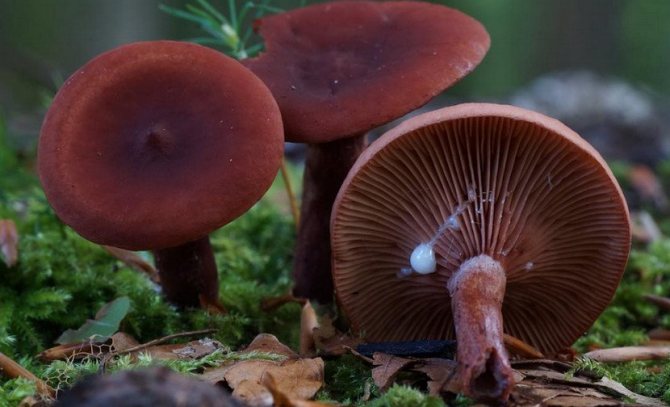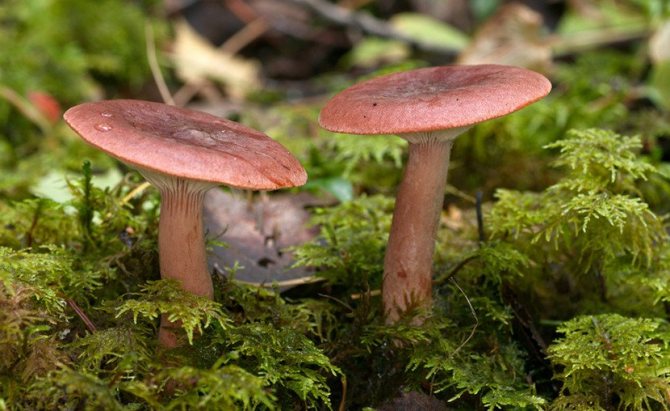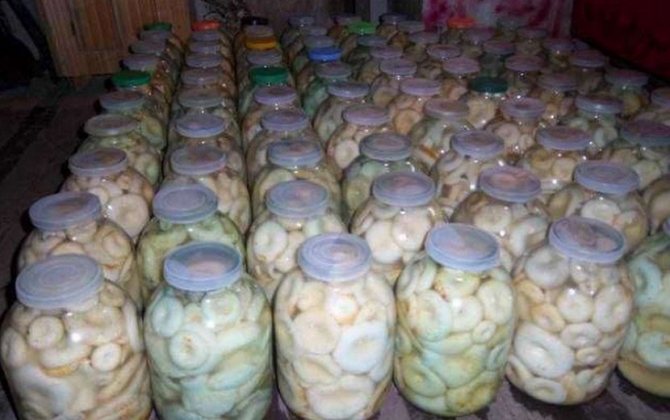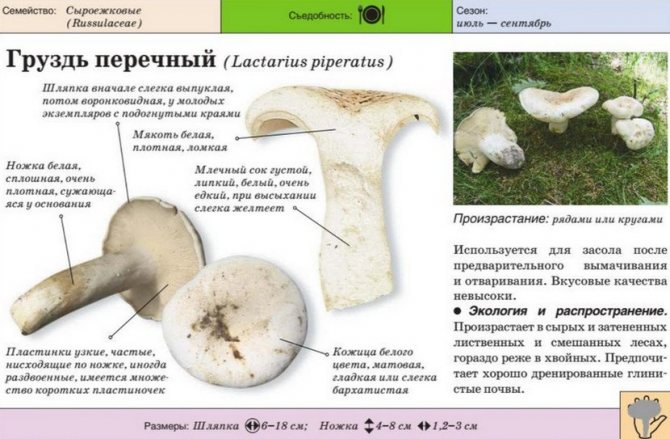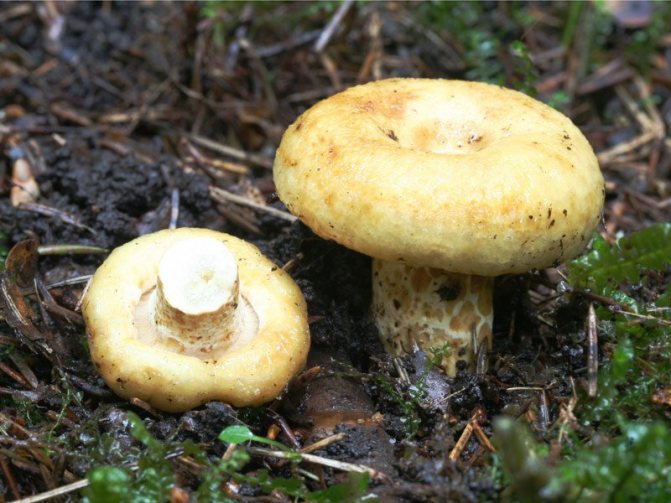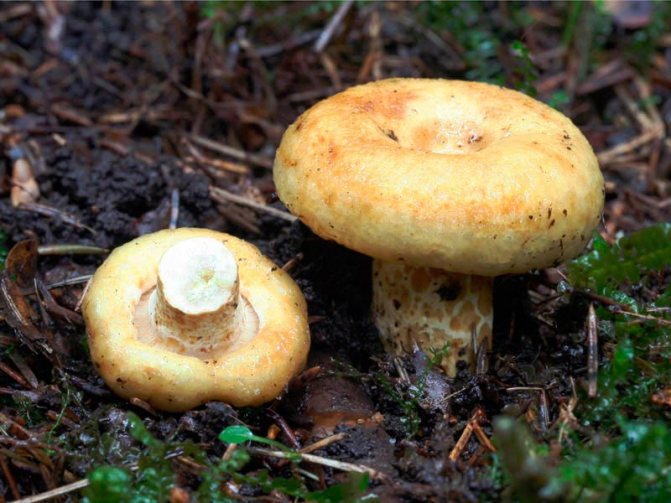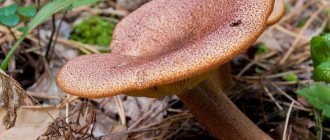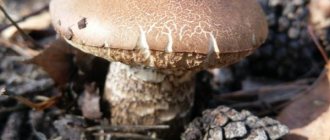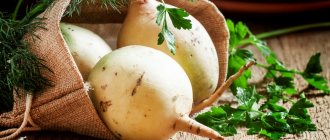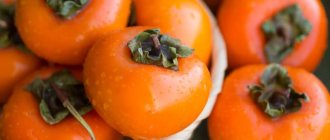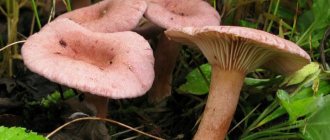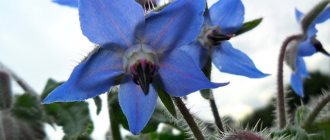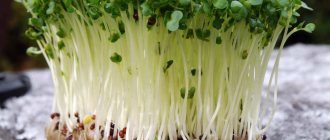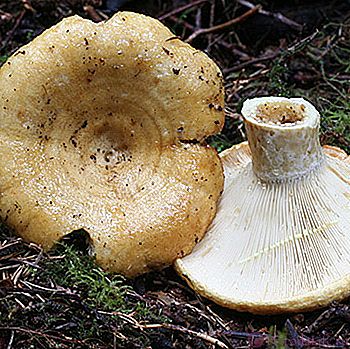
All types of mushrooms always grow in groups, their name comes from the Church Slavonic "mushroom" (heap). And the caps of adult specimens of edible milk mushrooms often reach 20 cm in diameter. So, going on a "quiet hunt" for real white milk mushrooms, mushroom pickers rarely come empty-handed.
Below you can see the photos and names of varieties of milk mushrooms and find out which edible milk mushrooms are best suited for pickling and pickling. You will also get an idea of what real milk mushrooms and other types of these edible mushrooms (yellow, bitter and red-brown) look like.
Types of mushrooms
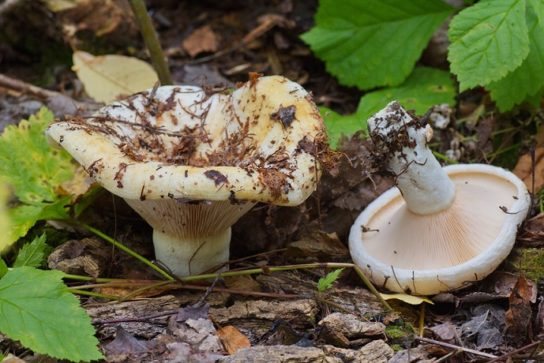
What are the main types of mushrooms picking mushroom pickers?
Real milk
All over the world, people are suspicious of conditionally edible mushrooms, and only in the Russian Federation is a real mushroom a delicacy. Young mushrooms are found from late July to mid-September, salted, eaten with sour cream and boiled potatoes.
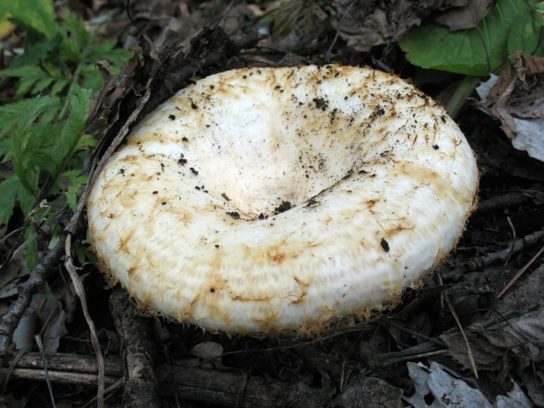

Real mushrooms grow in colonies in the grass, under foliage in birch and pine-birch tracts. They do not like light, they choose shaded, humid places, so mushroom pickers are looking for mushrooms with a stick, scattering the litter of the forest.
The pulp is firm, white, brittle with a pleasant and distinctive smell. If the mushroom is damaged, a caustic milky juice is released, it turns yellow in air, which spoils the aesthetic impression of the mushroom.
The mushroom cap is funnel-shaped, the fringe along the edge is always wet, even in dry weather, fluffy-fibrous. Young mushrooms have an almost flat white cap up to 10 cm in diameter with a downward curved edge. The diameter of the cap of mature mushrooms is about 20 cm, the color is slightly yellowish.
Cylindrical, smooth, white, hollow inside the leg, up to 5 cm thick. In old specimens it acquires a yellowish tint. Creamy-white frequent gills of the hymenophore pass from the cap to the leg.
Aspen milk
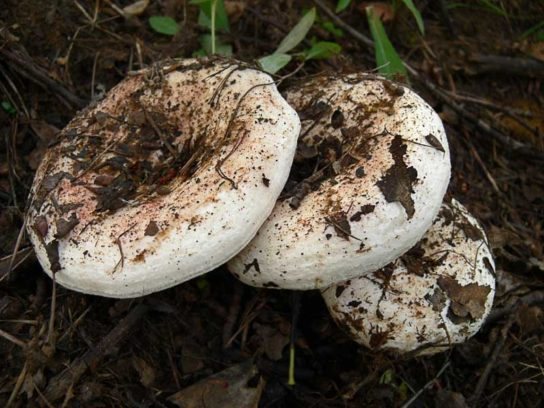

The well-known large funnel-shaped fungus exudes milky droplets (lactate) from the flesh and gills when damaged.
The aspen mushroom is distinguished by its pinkish gills and markings, often located in concentric rings on the top surface of the cap. Like other mushrooms of the genus, it has crumbly, not fibrous flesh. Mature specimens are funnel-shaped, with straight gills and a concave lid. It has dense flesh and a wide leg, which is shorter than the fruiting body. Spore print in creamy pink.
Usually, aspen mushroom grows next to creeping willow in wastelands and swamps and in aspen forests.


The mushroom is considered inedible in Western Europe due to its pungent taste, but it is eaten and harvested commercially in Serbia, Russia and Turkey.
Oak lump


Collect oak mushrooms in the fall in warm deciduous forests. The cap is large, up to 12 cm in diameter, hemispherical, with a central depression, crater-shaped with a smooth, intricate edge, wet and sticky in wet weather.
The gills are straight, dense, whitish-cream or ocher-cream in color. The stem is brownish in color, 3-6 cm in height, short, squat, straight, thickened in the center.
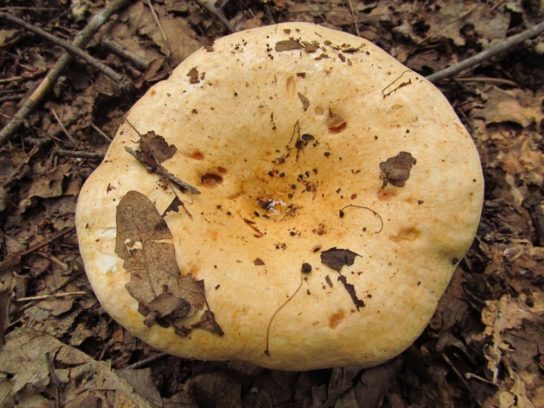

The flesh of the cap is white, hard and tough, fragile in the hollow stem. White milky juice plentiful, acrid. It is considered inedible in the West due to its intense bitterness.
Black milk
From Europe and Siberia, the black lump came to Australia and New Zealand.It grows under birches, spruces, pines and other trees in a mixed forest.


The cap is 8–20 cm across. The top is olive-brown or yellow-green, and in the middle is sticky or slimy. Young specimens have velvety shaggy zones along the edges. Later, the cap becomes funnel-shaped, the color darkens to blackish.
The gills are off-white, tinted olive brown with milky sap, which is initially white on contact with air.
The height of the leg is up to 7 cm, 3 cm in diameter, similar in color to the cap, but much lighter. The flesh is off-white, turning brown over time. The taste (especially milk) is pungent.
It is reported that this species contains the mutagen noncatorin, therefore it is not recommended for use. Boiling reduces the concentration of this compound, but does not eliminate it effectively.
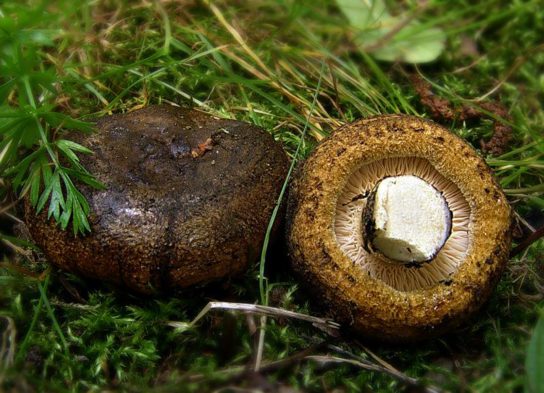

After cooking, black milk mushrooms are used as a spice in mushroom dishes in northern and eastern Europe and Siberia. Canned and pickled in Russia.
Dry weight


The mushroom is mostly white, with yellow-brown or brownish markings on the cap and a short, sturdy stem. An edible but not tasty mushroom grows in forests with coniferous, broadleaf or mixed trees.
Basidiocarps, it seems, do not want to leave the soil and are half buried, or grow hypogenically. As a result, rough caps 16 cm in diameter are covered with leafy debris and soil. They are white with a tinge of ocher or brown, with a fringed edge that usually remains white. At first, the caps are convex, but later smoothed and have a funnel shape.
Solid, white, short and thick stalk 2–6 cm high and 2–4 cm wide. The gills are straight and initially rather close together. The spore print is creamy white, warty oval spores 8–12 x 7–9 µm in size.
The pulp is white and does not change color when cut. In youth, the dry milk mushroom has a pleasant fruity smell, but in adulthood it develops a slightly fishy unpleasant odor. The taste is spicy, pungent.


Distributed in the northern temperate zones of Europe and Asia, especially in the Eastern Mediterranean. It is a thermophilic species that grows during the hotter seasons of the year.
This mushroom is edible, but tastes less than good. However, in Cyprus, as well as on the Greek islands, it is harvested and consumed after pickling in olive oil, vinegar or brine after a long boil.
Growing
At home, milk mushrooms can be grown in two ways:
- first option attractive for its cheapness. Spores from matured mushrooms are collected on their own. Then mycelium is grown from them. The problem is that it is almost impossible to predict the process of seed development. This method can only be used by experienced mushroom growers;
- the second way more expensive, but more reliable. The ready-made mycelium is bought in a specialty store and put into the substrate.
Growing milk mushrooms consists of several important stages:
Site preparation
The site chosen for planting must be well fertilized with peat. Young deciduous trees must grow on the site. They should not be more than four years old. You can use birch, poplar, willow and other hardwoods. The soil is disinfected with a lime solution;
Sowing
The best time to lay mycelium outdoors is between May and September. If you have a heated greenhouse, you can plant seeds at any time of the year;
Mycelium preparation
For sowing mushrooms, you need to prepare the substrate. For him, sterilized sawdust of deciduous trees is mixed with disinfected soil. To them are added forest moss from those places where milk mushrooms, fallen leaves, straw and hulls of sunflower seeds grow;
Sowing
If you plan to grow mushrooms outdoors, you need to prepare the mycelium wells.They are dug up close to the root system of the patron trees and half filled with the substrate. The mycelium is placed on top. And again the substrate to the edge of the hole. Then the soil must be tamped and covered with pieces of moss and leaves.
For growing indoors, the mycelium of the mushrooms is planted in a plastic bag filled with a substrate. Small cuts are made in the bag in a checkerboard pattern;
Care
To obtain a high yield, it is necessary to constantly water the mycelium and the trees under which it is located. In dry weather, at least 30 liters of water per week should be poured under each tree. Measures must be taken to protect the plantation from direct sun exposure. For the winter period, the mycelium should be covered with foliage and moss. Mycelium bags must be kept under specific conditions. Before the formation of fruiting bodies, the temperature should be maintained within 18 - 20 degrees. When mushroom sprouts appear, it must be reduced to 15 ° C, ensure the optimal level of lighting and humidity;
The harvest
Within a week after the formation of fruiting bodies, the milk mushrooms are gaining their usual weight. You can start harvesting in July and pick mushrooms until the end of August. They need to be carefully twisted out of the mycelium or cut with a knife at the root. A properly planted mycelium, with proper care, bears fruit for about five years.
Despite the peculiarities of taste and subtleties of preparation, the milk mushroom has been revered in Russia since ancient times. Having prepared it according to all the rules, you will get an excellent appetizer, a side dish, and aromatic pastries. This mushroom is worthy of being in your kitchen.
Where do milk mushrooms grow when they harvest
Milk mushrooms do not like loneliness. Places of mushroom families are chosen near lindens and birches. Harvested in late summer and autumn in deciduous or mixed forests. Fungi form vast colonies in glades where there is white clay near the surface.


Milk mushrooms are harvested from July until the first frost. Autumn harvests at a special price. Milk mushrooms at this time are not pungently bitter.
Milk mushrooms form symbiotic relationships with higher plants. Root systems exchange nutrients. Most species of mushrooms create colonies near birches. Fewer species prefer coniferous forests. The older the tree, the higher the likelihood of finding a mycelium near it.
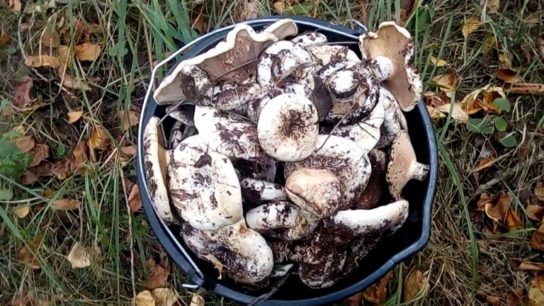

In young woods as tall as a man, milk mushrooms cannot be found. The older the forest, the higher the chance to catch these mushrooms.
For the growth of mushrooms, the following conditions are important:
- soil type;
- moisture in the earth;
- like the sun heats the ground.
Most species prefer places that are warmed by the sun, moderately moist with grass, moss or a litter of rotting leaves, they do not like dry and swampy areas.
Podgruzdok white


But this is not a milk mushroom at all and not even a milkman, but the most ordinary russula, very similar to the representatives of the noble mushroom breed. The main distinguishing feature is the absence of milky juice, for which this mushroom is often called “dry weight". By the way - thanks to this remarkable circumstance, the white pulp does not have the characteristic pungency of milk mushrooms. Therefore, it can be cooked without preliminary soaking or boiling.
In terms of taste, it is considered the best of all loads. Do not believe "Wikipedia", which claims that the mushroom has a supposedly "bland" taste - this is nothing more than the sofa rantings of amateurs who have seen mushrooms except in the supermarket. Dry milk mushrooms are very good, both salted and fried - with potatoes.
This fungus forms mycorrhiza with many trees. Podgruzdki have been seen under birch, oak, beech, aspen, alder, pine and spruce. But, as practice shows, most of them grow in birch forests. Fruiting dry lump from July to August.
Some common doubles
Milk mushrooms and other conditionally edible mushrooms of this family are not poisonous, but not very pleasant for the taste buds. People prepare mushrooms preparatory, then cook. The milk mushrooms are soaked, boiled for a long time with salt.
Pepper milk


The fruiting body of the fungus is creamy white; in mature specimens, the cap is funnel-shaped with many gills. When pressed, bleeds with a whitish milk with a peppery taste. Widely distributed in Europe, the Black Sea region in northeastern Turkey, the eastern part of North America, introduced to Australia. Forms a symbiotic relationship with deciduous trees, including beech and hazel, and grows in soil from summer to early winter.
Mycologists consider it inedible and poisonous; cooks do not recommend it because of its taste. It is difficult to digest when raw. In folk practice, it is used as a seasoning after drying, boiled, fried in butter, pickled, baked in dough.
The mushroom is prized in Russia. People collect pepper mushrooms during the dry season, when other edible mushrooms are less available. In Finland, cooks boil mushrooms many times, drain the water. In the latter, salted chilled water is stored all winter, marinated or served in salads.
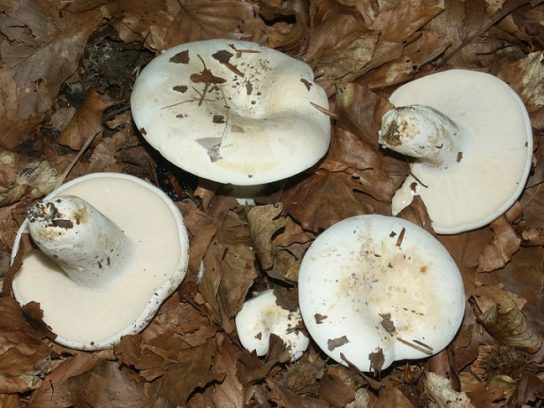

Eating fresh and raw mushrooms irritates the lips and tongue, the reaction goes away after an hour.
Milk camphor (camphor milk)
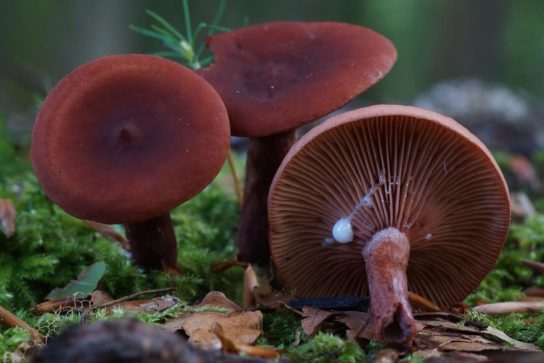

They appreciate it for its smell. Cooks use it as a spice, not for cooking. The size of the camphor lactarius is small to medium, the cap is less than 5 cm in diameter. Color from orange to orange-red and brown shades. The shape of the cap is convex in young specimens, flat and slightly depressed in mature mushrooms.
The fruiting body is fragile and brittle, giving off whitish and watery-looking milk, similar to whey or skim milk. The juice is weak or slightly sweet, but not bitter or pungent. The smell of the mushroom is compared to maple syrup, camphor, curry, fenugreek, burnt sugar. The aroma is weak in fresh samples, becomes strong when the fruiting body dries up.


Dried mushrooms are ground into powder or infused in hot milk. Some people use L. camphoratus to make smoking mixture.
Violinist (felt load)
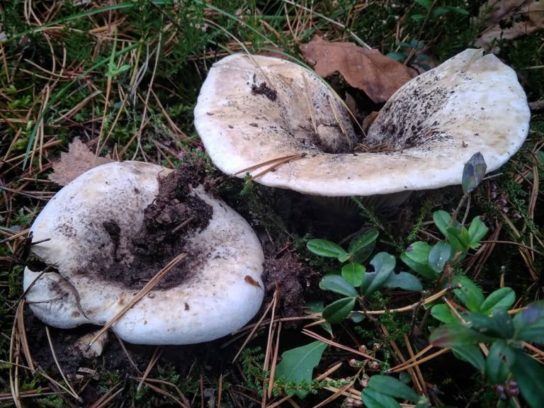

It is a fairly large mushroom found next to beech trees. The fruit body is dense, not fibrous, and if damaged, the fungus secretes colostrum. Mature specimens have white to cream-colored caps, funnel-shaped, up to 25 cm across. The wide leg is shorter than the fruiting body. The gills are distant from each other, narrow, with brown spots from dried sap. The spore print is white.
The mushroom is harvested in deciduous forests from late summer to early winter. Milk juice tastes neutral on its own, spicy if consumed with pulp. Felt milk mushrooms in the West are considered inedible because of their pungent taste. In Russia, it is soaked for a long time before cooking, then salted.
Milk golden yellow (golden milky)
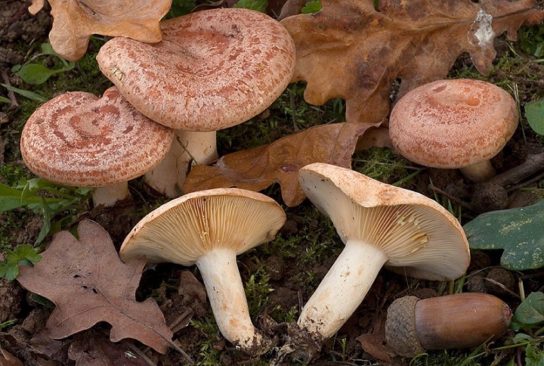

Has a pale color, poisonous, grows in symbiosis with oak trees. The cap is 3–8 cm across, with dark markings of coarse rings or stripes. At first, it is convex, but later smoothed out, in older specimens there is a small central depression, lint-free edges.
The whitish or pale yellow stem is hollow, cylindrical or slightly swollen, sometimes pinkish on the lower half. The gills of the hymenophore are frequent, straight, with a pinkish tinge, the spores are white-cream.
The whitish pulp has a pungent taste and is colored with abundantly secreted milk. Initially, colostrum is white, after a few seconds it becomes a bright sulfur-yellow.
The golden miller appears in summer and autumn in the northern temperate zones of Europe, North America and North Africa.
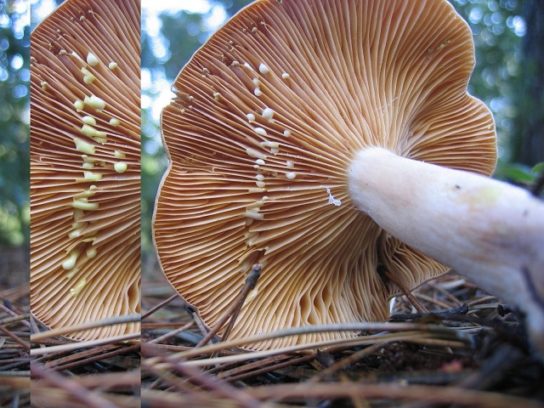

Consumption leads to predominantly acute severe gastrointestinal symptoms.
Cooking use
In Russia and the countries of the post-Soviet space, milk mushrooms are classified as conditionally edible mushrooms. In a number of Western countries, they are considered inedible and sometimes poisonous.
For those who love salted and pickled mushrooms, the milk mushroom is the perfect choice. Milk mushrooms prepared in this way will decorate any table and will be appreciated by sophisticated gourmets and simply lovers of delicious food.
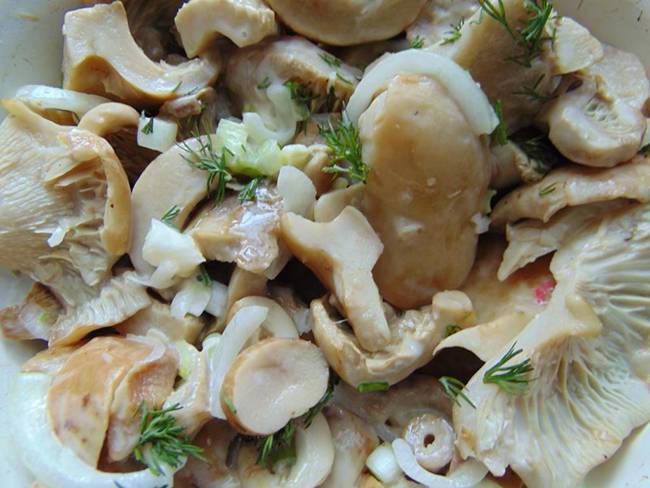

mushrooms: use in cooking
There are important rules to be observed when preserving milk mushrooms:
- a prerequisite for the preparation of milk mushrooms is their soaking. In order for the unpleasant bitterness to leave the mushrooms, they need to be kept in water for up to three days, changing the water from time to time. To find out if the mushrooms are soaked enough, you need to do the following: try a small piece of pulp (just chew, do not swallow). If you do not feel a bitter taste, then you can start cooking;
- it is not recommended to harvest old mushrooms that show rust-like stains. They acquire an unpleasant stiffness that does not pass even after long processing. In addition, old mushrooms contain many harmful substances that are absorbed by the mushrooms from the environment;
- wormy or insect-infested milk mushrooms are not suitable for salting;
- dirt and dust are deeply eaten into the pulp of these mushrooms. Therefore, you need to wash them thoroughly with a hard sponge or a toothbrush under running water;
- the container for salting can be glass, enameled, ceramic or wooden. There should be no cracks or rust on it;
- do not tightly seal dishes with salted or pickled milk mushrooms. This will help reduce the risk of getting botulism;
- salted milk mushrooms can be stored for no more than six months. Pickled ones last longer.
Pickling milk mushrooms
Products:
- A kilogram of mushrooms,
- litere of water,
- 110 g vinegar nine percent,
- 50 g of salt and the same amount of sugar.
Preparation:
After thoroughly cleaning and soaking the milk mushrooms, pour water with spices and cook after boiling for ten minutes. Fold into jars and close with lids.
Even more recipes on how to salt and pickle milk mushrooms for the winter
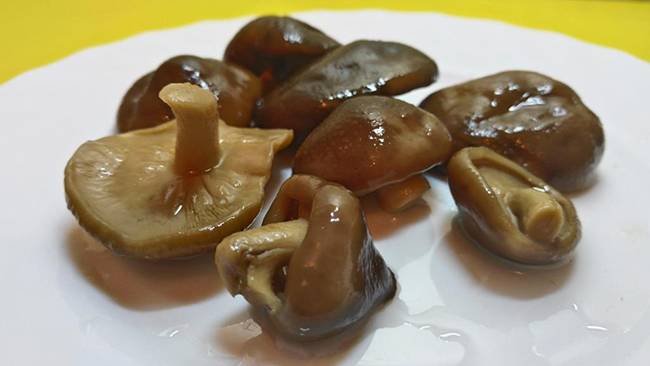

pickled milk mushrooms
Spicy mushrooms
Products:
- Mushrooms,
- currant or cherry leaves,
- a few cloves of garlic.
For the marinade, per liter of water is taken:
- 2 tbsp. l. salt,
- 25 g sugar
- spices (bay leaf, pepper).
Preparation:
Boil the prepared milk mushrooms for about 10 minutes. Then drain the water, and rinse the mushrooms again. Mix the products that make up the marinade and bring to a boil. Dip mushrooms in a hot marinade and boil for 15 minutes. Put cherry and currant leaves, chopped garlic, mushrooms in sterile jars. Pour a teaspoon of 9% vinegar into each jar. Pour boiling marinade over the mushrooms. Close the jars with sterile lids, wrap them in a blanket and allow to cool. Store mushrooms in a cool place.
Cold salting option
Products:
- for 5 kg of mushrooms you need:
- 2 cups coarse salt
- cherry leaves,
- currants,
- horseradish root and leaves,
- dill stalks,
- a few cloves of garlic.
Preparation:
Peel the mushrooms, wash and place in a suitable container. Fill completely with cold water. Place oppression on top. Leave the mushrooms in a cool place for three days. The water needs to be changed three times a day. After three days, remove the mushrooms from the water, rub them with salt one at a time and put them in a salting dish in layers, alternating with spices. Cover with cheesecloth folded several times, on which put horseradish, currant and cherry leaves. Put oppression on top again. After a few days, the milk mushrooms will be let in juice, which should completely cover them. We remove the prepared container for a month in a cool room. Make sure that the mushrooms are in the brine at all times. If necessary, you can add salted water. After a month, transfer the mushrooms to sterile jars and cork. You can store it in the refrigerator or cellar.
Many tasty and healthy dishes can be prepared from salted and pickled milk mushrooms.
Salted milk mushroom sauce
Products:
- salted milk mushrooms,
- onion head,
- sour cream,
- butter,
- some flour
- vegetable oil.
Preparation:
Chop mushrooms and onions and lightly fry in sunflower oil. Add water and simmer for ten minutes. In the next step, add sour cream. And after it boils, flour. Boil again. When the sauce is ready, add the butter to it. Perfect for vegetable and meat dishes.
Pie with milk mushrooms
Products:
Dough:
- 1 kg of flour
- 200 g of water
- 60 gr. sunflower oil,
- 25 g sugar
- 10 g salt
- 25 g yeast.
Filling:
- 900 g salted milk mushrooms,
- 2 onions
- 3-4 st. l. sunflower oil.
Preparation:
Pie filling: finely chop the onions and lightly sauté them in butter. Chop the mushrooms, add to the onion and fry for some time, cool. Prepare yeast dough from the proposed ingredients, roll out thinly and place on a baking sheet, lightly floured. Spread the mushroom filling evenly over it, pinch the edges and place in an oven preheated to 180⁰C. Bake until the dough is done.
Are milk mushrooms useful
- These mushrooms are nutritious, the pulp is fleshy and contains proteins (33 g in 100 g after drying), carbohydrates, minerals and vitamins in an easily digestible form. Boiled milk mushrooms replace meat and fish if these products are contraindicated.
- Vitamins of group B, A and C improve the function of the nervous system, hematopoiesis, immunity.
- Minerals in bioavailable form - sodium, magnesium, calcium and phosphorus, the active form of vitamin D are involved in the prevention of osteoporosis, maintain healthy skin and hair.
- The antibacterial agents of peppermint kill the tubercle bacillus, treat kidney stones in folk medicine.
- The fermentation and fermentation of mushrooms activates the production of lactic acid, anti-inflammatory and cholesterol-lowering substances.
Who shouldn't eat milk mushrooms
This is a heavy meal if a person has problems with the pancreas, liver and bile. Forest mushrooms are not given to children under 7 years of age and pregnant women. Frequent consumption of milk mushrooms containing active substances increases the sensitivity of the body, exacerbates allergic reactions.
Cooking, especially conditionally edible, milk mushrooms without observing technology is harmful to the activity of the digestive tract and the work of the excretory organs. For hypertensive patients and people with nephrosis, acute, salty and sour mushrooms are contraindicated. The occasional use of small portions of milk mushrooms is allowed.

